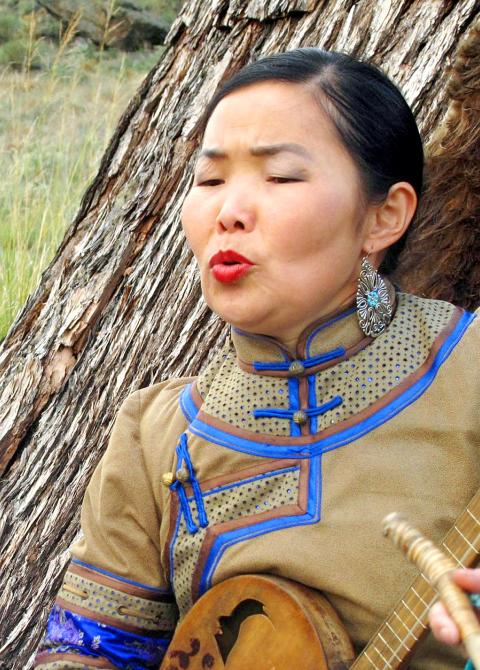The tiny Russian republic of Tuva, located in Siberia just north of Mongolia, will be the focus at Taipei’s Red Room this weekend. The three-day event kicks into high gear tonight with a concert featuring Tuva’s trademark throat singing along with both local and foreign talent.
The visiting throat singer — who can produce two or more tones simultaneously — is Choduraa Tumat, founder of an all-female folk ensemble who also plays the Jew’s harp and horse-head fiddle. She will share the stage with Atayal Aboriginal singer and dancer Pisui Ciyo, Paiwan Aboriginal double nose flute player Sauniaw, Mexican percussionist Ivan Alberto and Dutch performance artist and Siberian music expert Mark van Tongeren.
Tomorrow’s program, “A Touch of Tuva,” will focus on culture as Choduraa Tumat and others will be introducing the music, film, food, drink and even smells of the Tuvan grasslands and taiga. And finally, those who want to try throat singing can participate in workshops on Sunday.

Photo courtesy of Red Room
■ Tonight’s concert is from 7:30pm to 9:30pm at the Red Room, Taiwan Air Force Innovation Base (TAF 空總創新基地), 177, Sec 1, Jianguo S Rd, Taipei City (台北市建國南路一段177號). Tomorrow’s event is from 2pm to 6pm, also at the Red Room. The workshops are 10am to 1pm for beginners and 2pm to 5pm for advanced students at the Canjune Training Center, 4F, 3, Ln 151, Fuxing S Rd Sec 2, Taipei City (台北市復興南路151巷3號4樓)
■ Admission is NT$600 for tonight’s concert, tomorrow’s program is free. The workshops are NT$2,500 for each half day. Registration is required. Visit www.fusica.nl/a-touch-of-tuva-in-taipei for more details in both English and Chinese.

In the March 9 edition of the Taipei Times a piece by Ninon Godefroy ran with the headine “The quiet, gentle rhythm of Taiwan.” It started with the line “Taiwan is a small, humble place. There is no Eiffel Tower, no pyramids — no singular attraction that draws the world’s attention.” I laughed out loud at that. This was out of no disrespect for the author or the piece, which made some interesting analogies and good points about how both Din Tai Fung’s and Taiwan Semiconductor Manufacturing Co’s (TSMC, 台積電) meticulous attention to detail and quality are not quite up to

Chinese Nationalist Party (KMT) Chairman Eric Chu (朱立倫) hatched a bold plan to charge forward and seize the initiative when he held a protest in front of the Taipei City Prosecutors’ Office. Though risky, because illegal, its success would help tackle at least six problems facing both himself and the KMT. What he did not see coming was Taipei Mayor Chiang Wan-an (將萬安) tripping him up out of the gate. In spite of Chu being the most consequential and successful KMT chairman since the early 2010s — arguably saving the party from financial ruin and restoring its electoral viability —

It is one of the more remarkable facts of Taiwan history that it was never occupied or claimed by any of the numerous kingdoms of southern China — Han or otherwise — that lay just across the water from it. None of their brilliant ministers ever discovered that Taiwan was a “core interest” of the state whose annexation was “inevitable.” As Paul Kua notes in an excellent monograph laying out how the Portuguese gave Taiwan the name “Formosa,” the first Europeans to express an interest in occupying Taiwan were the Spanish. Tonio Andrade in his seminal work, How Taiwan Became Chinese,

Toward the outside edge of Taichung City, in Wufeng District (霧峰去), sits a sprawling collection of single-story buildings with tiled roofs belonging to the Wufeng Lin (霧峰林家) family, who rose to prominence through success in military, commercial, and artistic endeavors in the 19th century. Most of these buildings have brick walls and tiled roofs in the traditional reddish-brown color, but in the middle is one incongruous property with bright white walls and a black tiled roof: Yipu Garden (頤圃). Purists may scoff at the Japanese-style exterior and its radical departure from the Fujianese architectural style of the surrounding buildings. However, the property